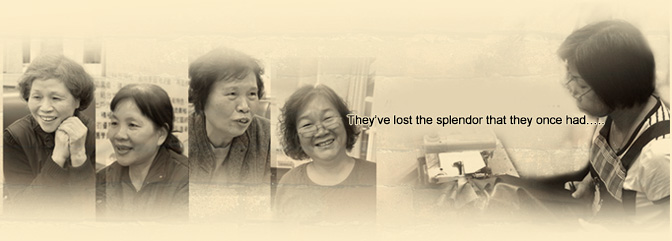2. Description of Our Community
Luzhou, located on the west bank at the downstream of freshwater river, was named "River Delta" at first. As a result of low topography, it is prone to flooding.
The earliest settlers in Luzhou were largely poor people from the south central part. They came to Luzhou for a living. Luzhou is next to Sanchong, which used to be a heavy industrial city, providing many employment opportunities,. The rural migration tide provided considerable human resources to the knitting industry and textile factories that are in great need of labor. For this geopolitical reason, Luzhou area became a place of settlement for the immigrants at the time. |
3. Summary of Our Project
The 1970s was the peak time for the development of Taiwan garment industry. The quantity and the production technology of knitting industry in Sanchong were mature then. With the establishment of several textile garment factories on the west side in the early times, the adjacent Luzhou area become one of cities for that textile garment factories outsource tailoring process at that time. In Luzhou area, there were a number of sewing workshops undertaking sewing businesses including clothing, gloves, etc. These small and exquisite sewing workshops were often hidden in the alleys or the first floor of big buildings. Inconspicuous as they were, they had many relevant weaving machines and old staff busily working inside of the doors. You will find the finished products piled aside are actually big clothing brand that we are all very familiar with.
We used the data from surveys and interviews to understand the history of the sewing workshops in Luzhou. We also tried to know the locations of those workshops near our school, and dig out the old stories behind them through ground visits to residents, businesses as well as employees. We also came to understand the hardships and difficulties of garment industry through actual participation in the work of these workshops. Finally, we promoted the Luzhou sewing workshops on campus, so that all the teachers and students would understand the close connection between sewing workshops and Luzhou. |
4. Our Computer and Internet Access
The IT equipment at our school is perfect, with each class having its own computers. The information center includes four computer rooms and the library. The network is 100MB fiber, with several Window2003 and Linux servers in the main room. The network equipments of team members in their homes also connected through wide band or fiber network. We also communicated through campus blog, hard disk and MAIL, etc. |
5. Problems We Had To Overcome
Challenge 1 The distribution of time and inconsistency of everyone’s time
The team members have to attend after-school classes, extracurricular classes or clubs after school or on weekdays. We also have many family activities Wednesday or weekends. Therefore the discussions of Cyberfair project can only be held during the break of morning study as well as the noon lunch. Sometimes we even had to skip regular classes to attend webpage making courses, distribute work, collect and organize data, discuss various activities, rehearse radio dramas, shoot films and make poster. We often had to ask for leaves on after-school classes or extracurricular classes in order to be meet.
Challenge 2 Limited interview and research capabilities
It was the first time to participate in the Cyberfair project for all members. Due to insufficient research experience, we didn't know where to start at the beginning. As many special research objects have already been researched and published about, we began to have clear themes and set the tone for our Cyberfair project only after long discussion. In order to get the members more prepared for the interviews, the teacher collected some interview materials beforehand. So the members would know how to design the questions and to conduct the interview. Through plenty of course and practice, we finally completed the design of interview questions and put what we had learned into practice.
Challenge 3 Lots of preparations to do prior promotion activities in school and community
We used a variety of ways for the promotion of this theme in school and community, including using posters, radio drama and other ways of propaganda. We had to paint poster and rehearse dramas beforehand. We also guided the students to know about the sewing workshops and textile industries. We also asked retired teachers, as well as the patchwork classes in community universities and Centre for seniors to guide members to sew puppets. After that, we asked members to teach students the whole process from painting the paper, cutting into pieces to making puppets. Besides the time pressure, the time-consuming tailoring and sewing steps was a major challenge as well. |
6. Our Project Sound Bite
The data we were able to collect on the internet for the Cyberfair project is limited. Most information had to be gained through ground visits and exploration. We appreciate the positive and warm support the interviewees have given to us. When looking at the data and pictures at the end of the project, we felt greatly moved and had a sense of fulfillment that can hardly be described by words. We were moved by all the encouragement, care and kindness we received throughout the whole process. We felt fulfilled because of the ever-enriching contents and dynamic performances of the members. Through the Cyberfair project, we learned a lot. We not just understood more about home and environment, but also realized that in our life there were many invisible histories that were gradually being forgotten. But all these footprints are very precious pieces of treasure the history of Taiwan!
|
